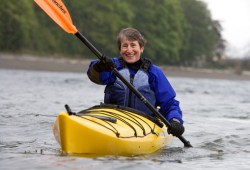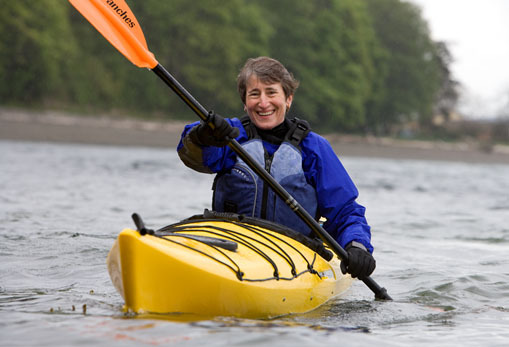
REI
Last week, President Obama nominated Sally Jewell, CEO of the outdoor gear giant REI, to head the Interior Department — the branch of government that manages national parks, monuments, and rangelands spanning from Ellis Island to Yosemite, and is currently overseeing an epic oil and gas drilling spree. Environmental groups are tripping over themselves to praise the president for his impeccable taste.
“In Jewell, President Obama chose a leader with a demonstrated commitment to preserving the higher purposes public lands hold for all Americans,” Sierra Club Executive Director Michael Brune gushed in a statement. Mike Daulton with the National Audubon Society called her “a strong leader who understands that protecting our natural world goes hand in hand with a strong American economy.” Bob Irvin, president of American Rivers, beamed that “she knows how important fishing, boating, and hiking and the great outdoors are to our families, to our future, and to our heritage as Americans.”
You get the picture. Why do the greenies love her so much? For starters, she’s a card-carrying conservationist with a long record of working to protect the wild places where she and her customers like to play. But there’s another reason Sally Jewell is the darling of Big Green groups: Her industry has given conservation cachet in Washington that it hasn’t enjoyed since the 1970s.
Much has been written about how environmentalists have failed to get substantial legislation through Congress since the golden age of the Clean Air and Water Acts. The particulars of their many failures are varied, but it basically boils down to this: Their opponents always manage to dumb the debate down to “jobs vs. the environment” — and when that happens, you can guess who wins. In Washington, as they say, money talks.
Not long ago, Jewell’s industry — made up of companies that manufacture and sell tents and backpacks and kayaks and such — was having similar problems. Frank Hugelmeyer, CEO of the Outdoor Industry Association, a trade group, remembers huddling over drinks at the Hyatt in Washington, D.C., after a frustrating day of lobbying on Capitol Hill in 2004. The industry was growing by leaps and bounds, but “in the halls of Congress, we were still being treating as tree-huggers,” he told me last spring as I was reporting a story about the industry for High Country News. “I remember saying, ‘We need to quantify this — the real true impact of outdoor recreation.'”
The notes they scribbled on a napkin that evening would inspire two years of work, funded by REI, aimed at putting a price tag on outdoor recreation nationwide. The resulting report, published in 2006, estimated that the outdoor business generated an astronomical $730 billion annually. The figure included everything from gear manufacturing and sales to hotel rooms and restaurant tabs, but if you start throwing numbers like that around, politicians’ ears perk up, Craig Mackey, the OIA’s director of recreation policy, told me. “That report has gained us an enormous amount of traction in Washington, D.C.”
The most recent industry report [PDF] — released at a press conference last summer where Jewell stood side by side with the president of off-road vehicle manufacturer Polaris and the governors of Utah and Washington — found that, if you toss in ORVs and power boats, Americans spend $645 billion a year on recreation. According to the industry, that number dwarfs what we spend annually on pharmaceuticals, cars, gas, or household utilities.
Under the Obama administration, OIA bigwigs and outdoor company CEOs have become regulars at D.C. press conferences unveiling initiatives to get more Americans recreating on public lands. (The industry’s interests dovetail conveniently with the Obamas’ fight against childhood obesity.) And now Jewell might be unveiling those initiatives herself instead of smiling silently off to the side.
And the environmentalists who love her so much? After decades of being blown off as dirty hippie backpacker types, they can finally declare, with a straight face and data to back them up, that protecting the public lands from oil and gas drilling and other ecological insults is not just the right thing to do — it’s also good for business.
Turns out that the argument has traction. In 2009, at the urging of outdoor industry leaders (among many others), Congress passed, and the president signed, the Omnibus Public Lands Act, protecting more than 2 million acres of new wilderness and more than 1,000 miles of newly designated wild and scenic rivers, and expanding the national parks and monuments system. Sens. Barbara Boxer (D-Calif.) and Ron Wyden (D-Ore.) both cited the OIA’s numbers in speeches supporting the bill.
Since that time, of course, we’ve seen the Tea Party revolution and a return to congressional gridlock. But now comes Jewell and the hope that, with her business savvy and the might of her industry, we might see more progress yet.
But will Jewell really be the answer to all the greenies’ prayers? If the Senate confirms her — and it’s hard to imagine that it won’t, despite flailing from right-wing pundits who say the one-time petroleum engineer is too green — she will be the first Interior secretary in at least 30 years who doesn’t wear a cowboy hat. This bodes well for those who value the public lands for things other than grazing cows, logging, and mining: Jewell is, above all, a business woman, but her loyalties clearly lie with those who view the public lands as a playground, not the source of commodities like minerals or meat.
Some have raised legitimate questions about whether the interests of Jewell’s industry line up with what’s best for the land. Off-road vehicle riders love nothing better than tearing up the virgin (and extremely fragile) deserts managed by Interior. And while “human-powered” recreation nuts like myself aren’t drilling and fracking the heck out of the public domain, we burn a fair amount of the resulting fuel in order to get to our favorite recreation areas. As Jewell herself quipped at the press conference last summer, “I don’t know anyone who walks to the trailhead.”
Jewell will no doubt continue her push to get more people — particularly young people and people of color — into the outdoors. That’s good for both the outdoor business and the environmental movement, which have become alarmed of late at the old age and whiteness of their customer/membership bases. It’s also a priority for land managers, who are under increasing pressure to make public lands “pay their way.” With land management budgets in shambles, we will likely see more pressure to outsource services like campground management to private companies and to create “public-private partnerships.”
But the biggest unknown surrounding public lands conservation is Jewell’s boss-to-be, President Obama. Republicans in the U.S. House of Representatives are sure to block any conservation measures from passing through Congress, and while Jewell can steer the department toward more eco-friendly land management, there is a limit to what she can do from inside a government juggernaut like Interior. That means that her most powerful tool for any lasting progress is to work through the president, via executive fiat.
President Clinton used his executive powers to create a pile of new national monuments at the encouragement of his Interior secretary, Bruce Babbitt. So far, however, Obama has shown little appetite for such action. He has made it clear that he plans to continue the oil and gas drilling orgy that his predecessor started. Meanwhile, he has protected less public land administratively than each of the four presidents who preceded him — even George W. Bush.
Can Jewell convince Obama to create a substantial conservation legacy, even if it’s only to shore up her beloved “recreation economy”? It might require getting him off the golf course and out onto the Potomac in a kayak — but then, I suspect that Jewell knows people who could provide the necessary gear and instruction.
CORRECTION: The original version of this story suggested that the outdoor recreation economy had shrunk between 2006 and 2011. A spokesperson for the Outdoor Industry Association tells us that, according to the industry’s numbers, it has been growing at approximately 5 percent a year.



